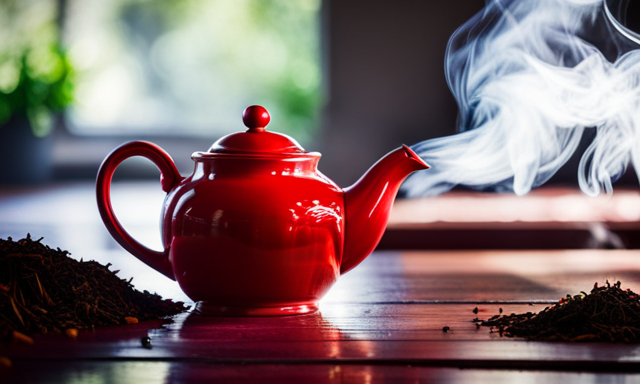Have you ever wondered how the delightful and soothing rooibos tea gets its unique flavor and aroma? Well, let me take you on a journey of discovery as we explore the fascinating process of how rooibos is fermented.
This magical transformation begins with the careful harvesting of the rooibos plant, followed by the meticulous preparation of its leaves. Then comes the pivotal step: the oxidation process, where the leaves undergo a natural chemical reaction that enhances their taste and color.
But it doesn’t stop there. The fermentation process takes center stage, adding depth and complexity to the tea’s character. The duration and temperature of fermentation play a crucial role in achieving the perfect balance of flavors.
Afterward, the leaves are carefully dried, sorted, and finally packaged for your enjoyment. Join me as we delve into the intricate world of rooibos fermentation and uncover the health benefits that this exquisite tea offers.
Get ready to savor every sip and embrace the wonders of this remarkable process.
Key Takeaways
- Fermentation enhances the taste and color of rooibos tea.
- Microorganisms (bacteria and yeasts) play a vital role in the fermentation process.
- The duration of fermentation is typically 12 to 24 hours.
- Microbial diversity influences the final taste and quality of the fermented rooibos tea.
The Origins of Rooibos Tea
You may be interested to know that the origins of rooibos tea can be traced back to the indigenous Khoisan people of South Africa. This unique herbal tea is cultivated from the leaves of the Aspalathus linearis plant, which is native to the Cederberg region.
The Khoisan people, who have a deep understanding of the land and its resources, discovered the potential of this plant for making a flavorful and caffeine-free beverage. They were the first to harvest wild rooibos plants and begin the process of fermentation, which brings out the distinct reddish-brown color and enhances the flavor of the leaves.
It was through their knowledge and expertise that rooibos tea became a beloved beverage. Now, let’s delve into the fascinating process of harvesting the rooibos plant.
Harvesting the Rooibos Plant
After enduring the intense heat of the South African sun, the resilient rooibos plant is plucked from the ground with a triumphant force. Harvesting the rooibos plant requires careful techniques to ensure its sustainability and quality.
The plants are typically harvested by hand, as this allows for selective picking of mature leaves and branches. This manual method also minimizes damage to the plant and surrounding vegetation. Harvesters must be skilled in identifying the optimal time to pluck the plant, which is usually during the summer months when the leaves are at their peak.
Once harvested, the rooibos plants are carefully sorted and processed to prepare the leaves for fermentation. This crucial step in the rooibos tea production will be discussed in the subsequent section, as we delve into the preparation of rooibos leaves.
Preparation of Rooibos Leaves
Get ready to savor the delightful process of preparing the leaves of this exceptional plant! Here’s a step-by-step guide on how rooibos leaves are prepared for fermentation:
-
Harvesting: The rooibos plant is carefully hand-picked, ensuring only the finest leaves and stems are collected.
-
Cutting and bruising: The harvested leaves and stems are cut into small pieces and bruised to initiate the fermentation process.
-
Moistening: The cut leaves are sprinkled with water, allowing them to absorb moisture and kickstart the fermentation.
-
Fermentation: The moistened leaves are placed in heaps and left to ferment for about 12 to 24 hours. During this time, natural enzymes are activated, giving rooibos its unique flavor and aroma.
Once the fermentation process is complete, the rooibos leaves move on to the oxidation process. This important step further enhances the flavor and characteristics of this beloved herbal tea.
Oxidation Process
The next step in the process is to let the leaves undergo the oxidation process, which adds depth and richness to the flavor profile of this beloved herbal tea.
During the oxidation process, the rooibos leaves are spread out and exposed to the air. This exposure allows the leaves to interact with oxygen, which triggers a series of chemical reactions. As a result, the green leaves gradually turn a reddish-brown color.
The length of the oxidation process can vary depending on the desired flavor profile, but it typically lasts between 6 and 12 hours. This process not only enhances the taste of the tea but also contributes to its unique aroma and color.
The oxidation process sets the stage for the subsequent fermentation process, where the leaves undergo further transformation.
Fermentation Process
To achieve a truly exquisite taste, you’ll need to allow the leaves to undergo a magical transformation through the fermentation process. After the oxidation process, the leaves are spread out in thin layers and left to naturally ferment.
This crucial step, often overlooked, is what gives rooibos its distinct flavor and aroma. During fermentation, microorganisms play a vital role in breaking down the compounds within the leaves, resulting in the development of unique flavors and the release of beneficial compounds. The microorganisms present, such as bacteria and yeasts, interact with the oxidized leaves, converting sugars into complex compounds.
This intricate dance between microorganisms and the oxidized leaves creates a symphony of flavors that sets rooibos apart from other teas. Now, let’s delve deeper into the fascinating role of microorganisms in fermentation.
Role of Microorganisms in Fermentation
During fermentation, microorganisms like bacteria and yeasts work their magic on the oxidized leaves, converting sugars into complex compounds and contributing to the development of unique flavors and aromas.
The microbial diversity present in the fermentation process plays a crucial role in determining the final taste and quality of the rooibos tea. Different fermentation techniques can be used to encourage the growth of specific microorganisms, resulting in different flavor profiles.
Studies have shown that the presence of certain beneficial microorganisms can enhance the antioxidant properties of the final product, making it even healthier to consume. Understanding and harnessing the power of these microorganisms is key to producing high-quality rooibos tea.
Speaking of fermentation, the duration and temperature of this process are important factors that will be discussed in the next section.
Duration and Temperature of Fermentation
During the rooibos fermentation process, microorganisms play a crucial role in converting the green leaves into the characteristic red-brown color and unique flavor. However, the duration and temperature of fermentation are equally important factors in achieving the desired outcome.
Fermentation of rooibos typically takes place for around 12 to 24 hours, allowing ample time for the oxidation process to occur. This duration ensures that the leaves develop their distinct taste and aroma.
Additionally, maintaining the appropriate temperature is vital for a successful fermentation. Rooibos is usually fermented at temperatures between 30°C and 40°C (86°F and 104°F). This temperature range promotes enzymatic reactions and microbial activity, leading to the desired flavor and color development.
Once the fermentation stage is complete, the next step involves drying and sorting the leaves to prepare them for packaging and distribution.
Drying and Sorting
Once the fermentation stage is complete, you can begin drying and sorting the leaves to prepare them for packaging and distribution. The drying process is crucial in preserving the flavor and aroma of the rooibos tea. It involves spreading the fermented leaves in a thin layer and exposing them to the sun for several hours. This allows the leaves to lose moisture naturally while retaining their unique characteristics.
Additionally, the leaves are occasionally turned to ensure even drying. After the drying process, the leaves are sorted to remove any impurities or damaged leaves. This is done by hand or using specialized machinery that separates the leaves based on size, color, and quality. The careful drying and sorting techniques ensure that only the finest rooibos leaves are selected for packaging and distribution.
Moving forward, the next step involves packaging and storage to maintain the freshness and quality of the tea.
Packaging and Storage
After the drying and sorting process, the next step in producing fermented rooibos involves packaging and storage. Packaging techniques play a crucial role in preserving the quality and flavor of the tea. The tea is carefully sealed in airtight containers to prevent moisture and air from degrading its taste and aroma. This ensures that the tea remains fresh and retains its distinct characteristics.
Additionally, storage methods are implemented to maintain the tea’s quality over time. The tea is typically stored in cool, dry environments, away from direct sunlight and strong odors that could alter its taste. By following proper packaging and storage practices, the fermented rooibos tea can be enjoyed for an extended period.
Speaking of enjoyment, let’s now explore the health benefits of fermented rooibos tea.
Health Benefits of Fermented Rooibos Tea
One of the significant advantages of incorporating fermented rooibos tea into your diet is the potential for improved overall well-being. Drinking fermented tea has been linked to numerous health benefits.
The fermentation process enhances the tea’s antioxidant properties, which can help protect the body against oxidative stress and reduce the risk of chronic diseases such as heart disease and cancer. Fermented rooibos tea also contains beneficial compounds like polyphenols and flavonoids, which have anti-inflammatory and immune-boosting effects.
Additionally, the fermentation techniques used in the production of rooibos tea can increase the bioavailability of certain nutrients, making them easier for the body to absorb. These health benefits make fermented rooibos tea a great addition to a balanced diet and a natural way to support your overall health and well-being.
Frequently Asked Questions
Is rooibos tea naturally fermented or does it require a specific process?
Rooibos tea undergoes a natural fermentation process that contributes to its unique flavor and health benefits. Unlike other teas, it doesn’t require a specific process. This makes rooibos an intriguing option for tea enthusiasts.
Can the fermentation process of rooibos tea be altered to produce different flavors?
Yes, different fermentation methods can be used to alter the flavors of rooibos tea. These methods can impact the antioxidant levels, providing a range of flavor profiles from fruity to earthy.
Are there any specific microorganisms involved in the fermentation of rooibos tea?
During the fermentation of rooibos tea, specific microorganisms play a crucial role. These microorganisms, such as Aspergillus niger and Saccharomyces cerevisiae, are responsible for breaking down compounds and producing unique flavors and aromas.
How does the fermentation process affect the caffeine content of rooibos tea?
Fermentation reduces the caffeine content in rooibos tea. Factors such as temperature and duration of fermentation play a role in determining the final caffeine levels. The longer the fermentation process, the lower the caffeine content.
Is there a recommended brewing method for fermented rooibos tea to maximize its health benefits?
To maximize the health benefits of fermented rooibos tea, it’s recommended to brew it using hot water at 195°F to 212°F for 5-7 minutes. This brewing method releases the tea’s antioxidants and polyphenols, promoting overall well-being.
Conclusion
In conclusion, the process of fermenting Rooibos tea is a meticulous and time-honored tradition. Every step is crucial in creating the perfect cup of tea, from the careful harvesting of the Rooibos plant to the precise oxidation and fermentation processes. The duration and temperature of fermentation are carefully controlled to enhance the flavor and aroma of the tea.
Once dried and sorted, the tea is packaged and stored, ready to be enjoyed. Fermented Rooibos tea not only offers a unique and delicious taste but also provides numerous health benefits.










